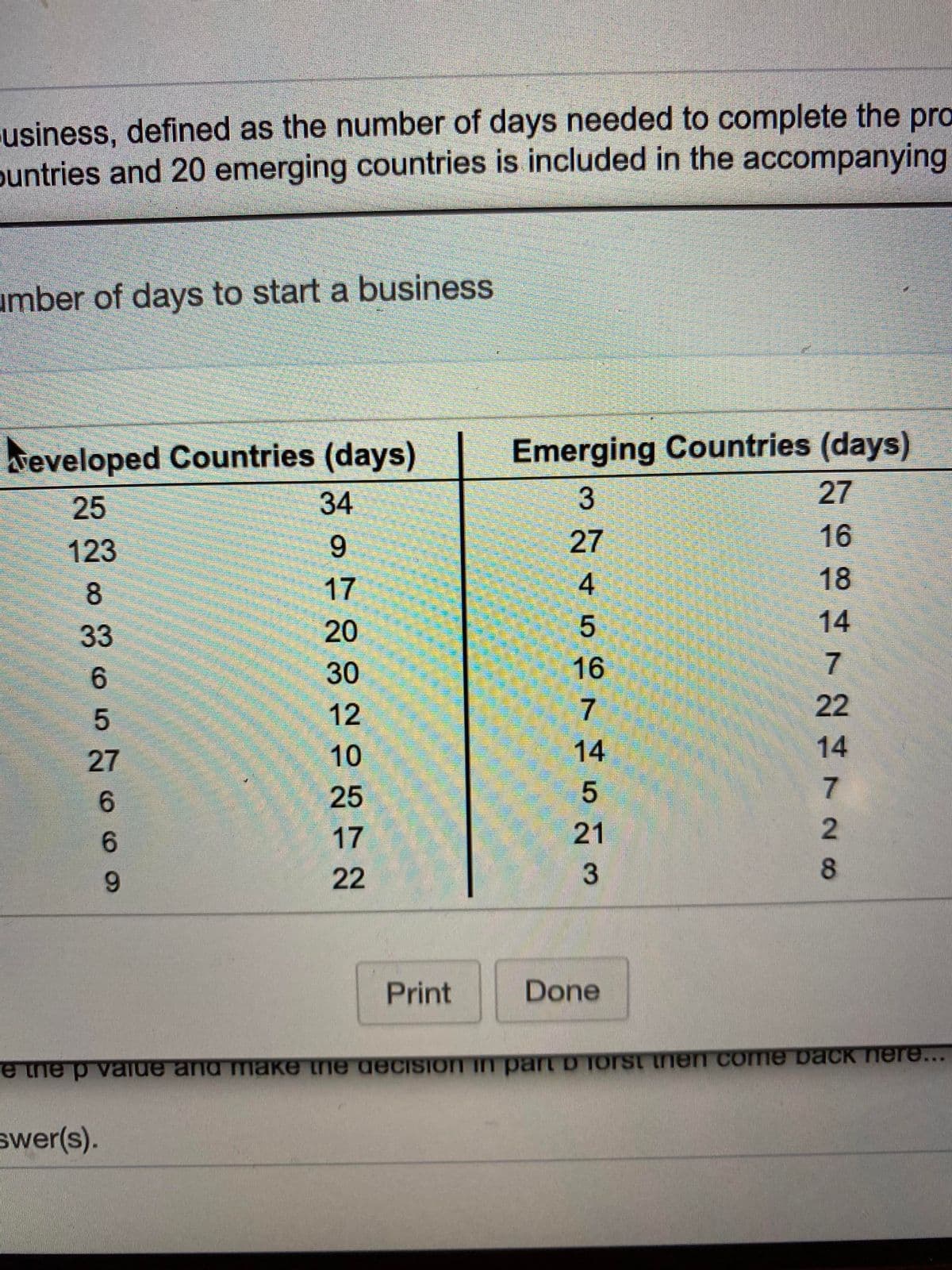The time required to start a business, defined as the number of days needed to complete the procedures to legally operate a business, in 20 developed countries and 20 emerging countries is included in the accompanying table. Assuming that the population variances for developed countries and emerging countries are equal, is there evidence of a difference in the mean time required to start a business between developed countries and emerging countries? (Use α=0.05.) Let μ1 be the mean time required to start a business in developed countries and let μ2 be the mean time required to start a business in emerging countries. What are the null and alternative hypotheses? A. H0: μ1=μ2 H1: μ1≠μ2 B. H0: μ1≠μ2 H1: μ1=μ2 C. H0: μ1≥μ2 H1: μ1<μ2 D. H0: μ1≤μ2 H1: μ1>μ2 t-stat=___ p-value=___ What is the correct conclusion? A. Reject H0. There is insufficient evidence of a difference in mean time required to start a business. B. Do not reject H0. There is insufficient evidence of a difference in mean time required to start a business. C. Do not reject H0. There is sufficient evidence of a difference in mean time required to start a business. D. Reject H0. There is sufficient evidence of a difference in mean time required to start a business. Choose the correct answer below. A. The two sample sizes are equal. B. The two populations have equal standard deviations. C. The hypothesis test must be a two-tail test so the results can be validly compared to a 95% confidence interval. D. The two populations are normally distributed. Construct a 95%confidence interval estimate of the difference between the population means of developed countries and emerging countries. ≤μ1−μ2≤ (Type integers or decimals rounded to two decimal places as needed.)
The time required to start a business, defined as the number of days needed to complete the procedures to legally operate a business, in 20 developed countries and 20 emerging countries is included in the accompanying table. Assuming that the population variances for developed countries and emerging countries are equal, is there evidence of a difference in the mean time required to start a business between developed countries and emerging countries? (Use α=0.05.) Let μ1 be the mean time required to start a business in developed countries and let μ2 be the mean time required to start a business in emerging countries. What are the null and alternative hypotheses? A. H0: μ1=μ2 H1: μ1≠μ2 B. H0: μ1≠μ2 H1: μ1=μ2 C. H0: μ1≥μ2 H1: μ1<μ2 D. H0: μ1≤μ2 H1: μ1>μ2 t-stat=___ p-value=___ What is the correct conclusion? A. Reject H0. There is insufficient evidence of a difference in mean time required to start a business. B. Do not reject H0. There is insufficient evidence of a difference in mean time required to start a business. C. Do not reject H0. There is sufficient evidence of a difference in mean time required to start a business. D. Reject H0. There is sufficient evidence of a difference in mean time required to start a business. Choose the correct answer below. A. The two sample sizes are equal. B. The two populations have equal standard deviations. C. The hypothesis test must be a two-tail test so the results can be validly compared to a 95% confidence interval. D. The two populations are normally distributed. Construct a 95%confidence interval estimate of the difference between the population means of developed countries and emerging countries. ≤μ1−μ2≤ (Type integers or decimals rounded to two decimal places as needed.)
Algebra & Trigonometry with Analytic Geometry
13th Edition
ISBN:9781133382119
Author:Swokowski
Publisher:Swokowski
Chapter10: Sequences, Series, And Probability
Section10.8: Probability
Problem 32E
Related questions
Topic Video
Question
The time required to start a business, defined as the number of days needed to complete the procedures to legally operate a business, in 20 developed countries and 20 emerging countries is included in the accompanying table.
Assuming that the population variances for developed countries and emerging countries are equal, is there evidence of a difference in the
Let
μ1
be the mean time required to start a business in developed countries and let
μ2
be the mean time required to start a business in emerging countries. What are the null and alternative hypotheses?A. H0: μ1=μ2
H1: μ1≠μ2
H1: μ1=μ2
H1: μ1<μ2
H1: μ1>μ2
t-stat=___
p-value=___
What is the correct conclusion?
Choose the correct answer below.
A. The two sample sizes are equal.
Construct a 95%confidence interval estimate of the difference between the population means of developed countries and emerging countries.
≤μ1−μ2≤
(Type integers or decimals rounded to two decimal places as needed.)

Transcribed Image Text:usiness, defined as the number of days needed to complete the pro
buntries and 20 emerging countries is included in the accompanying
umber of days to start a business
Emerging Countries (days)
27
eveloped Countries (days)
25
34
123
27
16
8
17
4
18
14
5
16
33
20
6.
30
12
7
22
27
10
14
14
6.
25
5
6.
17
21
6.
22
Print
Done
e the p value and make the decision in part D Torst then comne back here...
swer(s).
さ7Nさ728
3.
9.
Expert Solution
This question has been solved!
Explore an expertly crafted, step-by-step solution for a thorough understanding of key concepts.
This is a popular solution!
Trending now
This is a popular solution!
Step by step
Solved in 2 steps with 1 images

Knowledge Booster
Learn more about
Need a deep-dive on the concept behind this application? Look no further. Learn more about this topic, statistics and related others by exploring similar questions and additional content below.Recommended textbooks for you

Algebra & Trigonometry with Analytic Geometry
Algebra
ISBN:
9781133382119
Author:
Swokowski
Publisher:
Cengage

College Algebra (MindTap Course List)
Algebra
ISBN:
9781305652231
Author:
R. David Gustafson, Jeff Hughes
Publisher:
Cengage Learning

Algebra & Trigonometry with Analytic Geometry
Algebra
ISBN:
9781133382119
Author:
Swokowski
Publisher:
Cengage

College Algebra (MindTap Course List)
Algebra
ISBN:
9781305652231
Author:
R. David Gustafson, Jeff Hughes
Publisher:
Cengage Learning